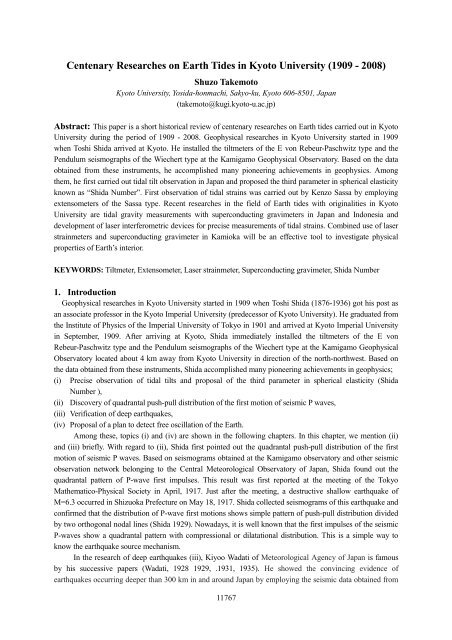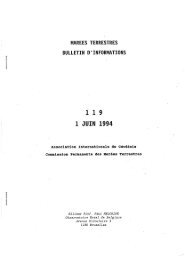marees terrestres bulletin d'informations - Université de la Polynésie ...
marees terrestres bulletin d'informations - Université de la Polynésie ...
marees terrestres bulletin d'informations - Université de la Polynésie ...
You also want an ePaper? Increase the reach of your titles
YUMPU automatically turns print PDFs into web optimized ePapers that Google loves.
Centenary Researches on Earth Ti<strong>de</strong>s in Kyoto University (1909 - 2008)<br />
Shuzo Takemoto<br />
Kyoto University, Yosida-honmachi, Sakyo-ku, Kyoto 606-8501, Japan<br />
(takemoto@kugi.kyoto-u.ac.jp)<br />
Abstract: This paper is a short historical review of centenary researches on Earth ti<strong>de</strong>s carried out in Kyoto<br />
University during the period of 1909 - 2008. Geophysical researches in Kyoto University started in 1909<br />
when Toshi Shida arrived at Kyoto. He installed the tiltmeters of the E von Rebeur-Paschwitz type and the<br />
Pendulum seismographs of the Wiechert type at the Kamigamo Geophysical Observatory. Based on the data<br />
obtained from these instruments, he accomplished many pioneering achievements in geophysics. Among<br />
them, he first carried out tidal tilt observation in Japan and proposed the third parameter in spherical e<strong>la</strong>sticity<br />
known as “Shida Number”. First observation of tidal strains was carried out by Kenzo Sassa by employing<br />
extensometers of the Sassa type. Recent researches in the field of Earth ti<strong>de</strong>s with originalities in Kyoto<br />
University are tidal gravity measurements with superconducting gravimeters in Japan and Indonesia and<br />
<strong>de</strong>velopment of <strong>la</strong>ser interferometric <strong>de</strong>vices for precise measurements of tidal strains. Combined use of <strong>la</strong>ser<br />
strainmeters and superconducting gravimeter in Kamioka will be an effective tool to investigate physical<br />
properties of Earth’s interior.<br />
KEYWORDS: Tiltmeter, Extensometer, Laser strainmeter, Superconducting gravimeter, Shida Number<br />
1. Introduction<br />
Geophysical researches in Kyoto University started in 1909 when Toshi Shida (1876-1936) got his post as<br />
an associate professor in the Kyoto Imperial University (pre<strong>de</strong>cessor of Kyoto University). He graduated from<br />
the Institute of Physics of the Imperial University of Tokyo in 1901 and arrived at Kyoto Imperial University<br />
in September, 1909. After arriving at Kyoto, Shida immediately installed the tiltmeters of the E von<br />
Rebeur-Paschwitz type and the Pendulum seismographs of the Wiechert type at the Kamigamo Geophysical<br />
Observatory located about 4 km away from Kyoto University in direction of the north-northwest. Based on<br />
the data obtained from these instruments, Shida accomplished many pioneering achievements in geophysics;<br />
(i) Precise observation of tidal tilts and proposal of the third parameter in spherical e<strong>la</strong>sticity (Shida<br />
Number ),<br />
(ii) Discovery of quadrantal push-pull distribution of the first motion of seismic P waves,<br />
(iii) Verification of <strong>de</strong>ep earthquakes,<br />
(iv) Proposal of a p<strong>la</strong>n to <strong>de</strong>tect free oscil<strong>la</strong>tion of the Earth.<br />
Among these, topics (i) and (iv) are shown in the following chapters. In this chapter, we mention (ii)<br />
and (iii) briefly. With regard to (ii), Shida first pointed out the quadrantal push-pull distribution of the first<br />
motion of seismic P waves. Based on seismograms obtained at the Kamigamo observatory and other seismic<br />
observation network belonging to the Central Meteorological Observatory of Japan, Shida found out the<br />
quadrantal pattern of P-wave first impulses. This result was first reported at the meeting of the Tokyo<br />
Mathematico-Physical Society in April, 1917. Just after the meeting, a <strong>de</strong>structive shallow earthquake of<br />
M=6.3 occurred in Shizuoka Prefecture on May 18, 1917. Shida collected seismograms of this earthquake and<br />
confirmed that the distribution of P-wave first motions shows simple pattern of push-pull distribution divi<strong>de</strong>d<br />
by two orthogonal nodal lines (Shida 1929). Nowadays, it is well known that the first impulses of the seismic<br />
P-waves show a quadrantal pattern with compressional or di<strong>la</strong>tational distribution. This is a simple way to<br />
know the earthquake source mechanism.<br />
In the research of <strong>de</strong>ep earthquakes (iii), Kiyoo Wadati of Meteorological Agency of Japan is famous<br />
by his successive papers (Wadati, 1928 1929, .1931, 1935). He showed the convincing evi<strong>de</strong>nce of<br />
earthquakes occurring <strong>de</strong>eper than 300 km in and around Japan by employing the seismic data obtained from<br />
11767



